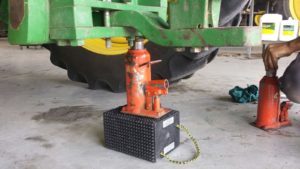Using timber blocks to support or stabilise a large piece of equipment or a heavy load has long been accepted practice, but experience has shown that it’s not the safest or most efficient option
Occupational health and safety professionals know that timber, when used as a support, is a serious safety risk for workers, being unpredictable, unsafe and unnecessary.
Yet remarkably, it is still being used as a propping and/or support tool across a wide range of industries, including mining, manufacturing, agriculture, construction and engineering sectors.
The fact is timber is not a tool, and should never be used as one.
While dunnage and blocks made of timber have traditionally been used for blocking and cribbing in industrial applications, they are not engineered as fit-for-purpose tools for applications such as supporting machinery and equipment when carrying out assembly, repairs and maintenance tasks.
Cribbing & Matting Co Managing Director Tony Brooks says the problem arises when people take random pieces of timber to use as support devices knowing nothing about the species or the state of the timber.
“For all they know, it might just be a piece of pine, and totally un-suitable.”
He explains that timber is not a tool and only quality manufactured cribbing blocks and specially designed metal stands can be recognised as purpose-built tools for stabilising heavy equipment.
“I do appreciate that industry is slowly recognising the benefits of plastic engineered cribbing blocks, but the process is not fast enough.
“We still have too many workers being killed or injured in our workplaces needlessly.”
As Brooks points out, the structural integrity of timber, or lack of it, cannot often be identified until it’s too late.
“A timber block may be perfect the day you buy it, but the danger comes as it ages and gets exposed to certain elements.
“For example, timber in moist conditions will absorb water and become structurally unsound, while timber exposed to excessive heat becomes brittle.
“And when timber starts to creak, that is the sound of internal grains rupturing like splits and cracks rubbing together.
“At this stage the damage has already occurred, and the creaking sound is a warning. For when timber’s load-bearing effectiveness is compromised, it can fail completely and often catastrophically. “
And with timber blocks often exposed to chemicals, solvents, fuels and other contaminants in the workplace, Brooks says they present further risks to workers’ health.
“For example, if a worker gets a splinter it could easily be contaminated by a foreign object, which has the potential to make any injury to the worker significantly worse.”
Brooks advises that there are plastic engineered cribbing blocks available on the market, which are far superior to timber regarding safety, efficiency and the environment.
“To start with our Dura Crib plastic engineered jacking and cribbing blocks have an authenticated Working Load Limit (WLL), something timber blocks can never achieve.
“Plus, each of our Dura Crib plastic engineered jacking and cribbing blocks possesses a uniform load-bearing capacity across the entire block.
“This is due to the blocks having a specific chemical composition that is constantly repeated, and a quality manufacturing process that ensures all products are the same, plus or minus five per cent. “
Brooks explains that the high-performance Dura Crib range was specifically developed to replace older, weaker timber cribbing systems with varying and unpredictable load-bearing capabilities.
“Not only is timber impossible to authenticate for Working Load Limit, timber blocks require ongoing replacement involving extensive handling, consumption and disposal of a finite resource.
“In addition to the wastage of scarce hardwoods, there are growing disposal problems with old timber cribbing, which is often soaked with oil, chemicals and hazardous waste products.
“Such hazardous substances contained in contaminated timber cribbing cannot be just dumped into landfill, as it presents a major risk to the environment.”
Instead, as he points out, the lightweight Dura Crib range of jacking and cribbing is resistant to fuels, oils and most common industrial solvents and chemicals, and is backed by a 50-year warranty against splitting, rot, fluid absorption, termites and mould.
Available in hi-visibility yellow or standard black, the cribbing is manufactured from 100% recycled high density polyethylene (HDPE) construction for durability and tested under the guidance of AS1170.0.2002 and AS2498.3.1998.
Dura Crib systems have been extensively proven under some of the world’s toughest safety regimes.
A major advantage of Dura Crib is that it is a complete system of integrated products that can be combined to provide comprehensive solutions across a wide range of industries including mining, materials handling, building, construction and manufacturing.
Dura Crib offers complete solutions and continuity of supply for particular applications, rather than piecemeal product ranges and erratic availability.
Offering outstanding strength and stability, Dura Crib is suitable for both active cribbing, where a person is working on, underneath or near the supported load, and for passive cribbing, where cribbing is used to keep the load off the ground, allowing forklift access for example.
“This is a truly durable and sustainable system, whereas the only guarantee with timber is that you will eventually have to replace it,” Brooks says.
“Dura Crib provides an engineered and easily handled system and is the safest and fastest way to stabilise loads, including machinery and vehicles ranging from cars to heavy trucks.
“By ensuring stability quickly and easily in all industrial situations, it saves time and money and protects workers,” Brooks concludes.




